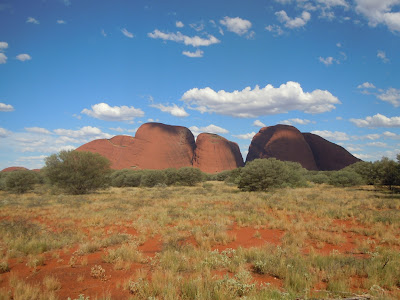After awaking and having a quick breakfast, Isabella and I continued south along the Stuart. The aboriginal people who had camped the night before had moved on. We encountered their convoy on the way south to Coober Pedy and we later learned that there was some important cultural gathering happening in the hills around Coober Pedy. We can only assume that that's where they were headed.
Along the road to Coober Pedy we stopped at an inconspicuous fence crossing the highway. It doesn't look important, much like any other boundary demarcating fence, but this one is special for 2 reasons: it crosses the highway (which is unusual) and it's part of the longest fence in the world. This is the famous Dingo Fence that stretches more than 5 000 kilometers from the Great Australian Bight to southern Queensland. It is about 2 000 kilometers longer than the Great Wall of China.
The Dingo Fence, or Dog Fence or Vermin Proof Fence, was built by pastoralists who wanted to protect their flocks from ravenous dingoes. On the south side of the fence there tend to be sheep but on the north side there tend to be cattle, which are too big for a dingo to tangle with. It continues to be maintained by farmers and does, at least to some extent, keep out the dingoes.
After our brief highway stop, Isabella and I continued to Coober Pedy. We stopped there and took a brief trip down the Oodnadatta Track, nothing more than a flattened dirt road, to where the Dingo Fence crosses that road. The weather-beaten sign says that the fence extends to Surfers Paradise in Queensland but I suspect that is for tourists. As far as I can tell, the fence ends in Jambour significantly further inland. I suppose statements written on signs aren't written under oath.
At this point there is also the Moon Plain, a barren featureless expansive void of rock. It is aptly named as standing alone on the Moon Plain gives a sense of complete desolation and isolation. If not for the Oodnadatta Track, no one would dare cross this place.
After leaving this harsh place, Isabella and I returned to the Stuart Highway and continued south. Along the way we stopped for lunch at Pimba, the roadside gas station that serves as an entrance to Woomera. It was here that I remembered why I liked eating in remote Australian locales --- the portions. I ordered a t-bone steak and even though the meal cost $22, the steak was quite large. It was something I had noticed when travelling in Tasmania as well. Having dined heartily, Isabella and I continued south towards Port Augusta, and somewhere along the way, though no one can say where exactly, we left the Outback.
We drove into Port Augusta in the early evening and decided to take a stroll around the town. There really wasn't much to it but Isabella had a guide book that gave a self-guided tour of the city. We walked by many old buildings and some places where buildings had one stood but had since been demolished. There were even the remains of an old ship near the harbour. We also walked by Port Augusta's landmark domed Town Hall but on closer inspection, it looked rather run down. Having seen a few photos of it, though from farther away, I thought the Town Hall would be better maintained but I guess times are hard in Port Augusta.
Isabella and I decided to camp in the Mount Remarkable National Park, a way to the south of Port Augusta. We decided to camp in the back area of the park, as had many others it seemed. I thought the most interesting part was that to pay for the night you take an envelope from the park entrance, put in the appropriate amount, fill in your vehicle details and then deposit it in a box at the entrance. This was all new to me but Isabella knew the procedure well as a park employee. We settled down for the night in our tent under a large tree. After some fairly exhausting days of driving, tomorrow's drive to Adelaide would be short and we'd have a chance to hike in the park.




















